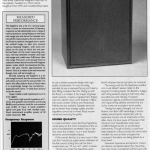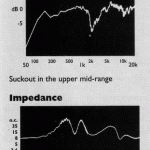Extract from a round up of six £200 speakers in Hi-Fi World, June 1992. For sake of conciseness, I have just reproduced the review of the Royd Sapphire (version 1) and the snippets from the final overall conclusion.
ROYD SAPPHIRE
£198Royd’s Sapphires were the smallest speakers of the group, looking quite tiny for the price. All the same, their poundage was not so different to their larger rivals. This is a two-way reflex design, using a small five-inch main driver specifically designed, Royd say, for the cabinet, Tweeter is a 19mm dome bought-in from VIFA and modified. Royd claim to use a simple crossover design with high-quality components. It’s very tempting normally to use a rearward-facing port tube to help lifting a speaker like this. Doing so with the Royd is a mistake. It has a layer of grease which instantly, it seems, migrates from fingers onto the cabinet. Ours were finished in Black Ash wood veneer; Walnut and Rosewood finishes are also available. Speaker terminals are no better than average quality and the Sapphires cannot be bi-wired. Royd recommend not removing the grilles.
SOUND QUALITY
In a demonstration room the Royd Sapphires would easily be the most impressive of the six pairs of loudspeakers we tested. Not in size – they were the smallest – but in their forceful dynamics and immediate impact.
If this sounds familiar, it is very much in the Linn Kan mould, but scaled down, Admirers of the Kan sound, lacking the cash for them, would surely say “I’ll ‘ave ’em” within minutes.
Timing was where the Sapphires were strongest. Pace and rhythm were spot-on, diverse changes in musical programmes dealt with easily and with precision. These Royds played music with more presence than any other speaker in this group could muster; bass and percussion were more positive, the treble more dynamic, everything well up-front.
In fact this sheer dynamism and verve could turn into one of the Sapphires’ biggest problems. Add a bright, sharp amplifier, and it could fast become tiring. The initial impressiveness wears away as their tonal qualities become more evident. The treble performance is ragged and uneven, the voice of Tim Booth of James becoming harsh, for example.
The energy and fire the Sapphires breathe into music doesn’t always relate to the programme being played. On Barber’s Adagio, with string sections playing in harmony, they sounded easy and relaxing. However, comparison against a reference loudspeaker with equal timing abilities, showed that the violins were not accurate in tonal quality.
Testing this aspect brought out one of Robert Von Bahr’s BIS recordings, a simply- miked, pre-eminently natural disc with an expansive acoustic are all trademarks of this label. Here, the four saxes of Francaix’s Petit Quatuor pour Saxophones were quite undifferentiated tonally, or as individual instruments. Though so lively it could have been played in a disco, tonally the instruments melded into one another and gave the impression the piece was being played by a brass band.
However impressive and dynamic, there’s an obvious wrongness about this. Nevertheless, rock music is projected well forward with such forcefulness behind it that the Sapphires will gain their devotees for this aspect of their performance alone.CONCLUSION
A mixed bag of positives and negatives, are the Sapphires. On one side, they are impressively dynamic and musically powerful. They produce a big, fast, even deep, sound which belies their small size. While they make enjoyable music, always setting feet tapping, this is at the expense of instruments’ true tonal qualities, a property that can be seriously off-putting.
MEASURED PERFORMANCE
The Sapphire was a bit of a moving target when it came to measurement. Frequency response varied substantially over a range of vertical positions, being flattest on the bass/ mid-range axis and above the tweeter axis. Like all the response plots, the one shown of the Royd is position averaged over a sensible vertical range, to take into account various listening ‘heights’, with some emphasis on the axes at which the unit performed best. At the usual measuring position, mid-way between tweeter and bass/ mid-range unit, treble was -5d8 lower than mid-range. However, most people listen at a distance where the drive units will integrate better, under which circumstance the Sapphire will give results approximately as shown. Since it is meant to be wall mounted though, bass will be brought up.
Broadly Speaking, the Sapphire is a bit mid-range forward, but the suckout at 2kHz will soften and smooth the sound a little. I’ve heard this effect before from a Royd; often it is surprisingly benign but sometimes – especially with violins – it really does dull and mute the sound.
Upper treble is well maintained, but it is a bit ragged.
Even with a high overall impedance of 11 ohms, this speaker was sensitive, producing 86dB sound pressure level for one nominal watt (2.8W) of input. It loads amplifiers lightly and goes loud with modest input. Royd recommend amplifier power of 40 watts maximum. NK
Snippets from the final round up conclusion, relating to the Royd Sapphire:
Royd’s Sapphires pole-vaulted to the opposite extreme. They could adopt ‘If anyone Kan, Royd Kan as well’ as an advertising slogan. Here the trademark was a furiously projected up-beat sound; most often more upbeat than music. The smallest of this bunch, they drove music fast and furious, and in time. Yet unless you are a determined fan of a disco-type dominance of rhythm, they might drive you from your listening room as well. It’s fine for heavy rock – and the Royd’s rock with the best. But how much rock’n’roll do you want with you Nutcracker Suite?
 ROYD SAPPHIRE
ROYD SAPPHIRE MEASURED PERFORMANCE
MEASURED PERFORMANCE


